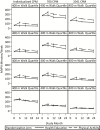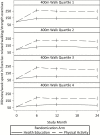Evaluating Accelerometry Thresholds for Detecting Changes in Levels of Moderate Physical Activity and Resulting Major Mobility Disability
- PMID: 28977340
- PMCID: PMC5905614
- DOI: 10.1093/gerona/glx132
Evaluating Accelerometry Thresholds for Detecting Changes in Levels of Moderate Physical Activity and Resulting Major Mobility Disability
Abstract
Background: An important decision with accelerometry is the threshold in counts per minute (CPM) used to define moderate to vigorous physical activity (MVPA). We explore the ability of different thresholds to track changes in MVPA due to a physical activity (PA) intervention among older adults with compromised function: 760 CPM, 1,041 CPM, and an individualized threshold. We also evaluate the ability of change in accelerometry and self-reported PA to attenuate treatment effects on major mobility disability (MMD).
Methods: Data from a week of hip worn accelerometers and self-reported PA data (30-day recall) were examined from baseline, 6-, 12-, and 24-months of follow-up on 1,528 older adults. Participants were randomized to either PA or Health Education (HE). MMD was objectively defined by loss of ability to walk 400 m during the follow-up.
Results: The three thresholds yielded similar and higher levels of MVPA for PA than HE (p < .001), however, this difference was significantly attenuated in participants with lower levels of physical function. Self-reported PA that captured both walking and strength training totally attenuated the intervention effect for MMD, an 18% reduction to a 3% increase. Accelerometer CPMs showed less attenuation of the intervention effect.
Conclusions: Accelerometry assessment within the LIFE study was not sensitive to change in level in physical activity for older adults with very low levels of physical function. A combination of self-report and objective measures are recommended for use in physical activity intervention studies of the elderly; limitations of accelerometry deserve closer attention.
Figures



Similar articles
-
Relationships Between Profiles of Physical Activity and Major Mobility Disability in the LIFE Study.J Am Geriatr Soc. 2020 Jul;68(7):1476-1483. doi: 10.1111/jgs.16386. Epub 2020 Mar 20. J Am Geriatr Soc. 2020. PMID: 32196636 Free PMC article. Clinical Trial.
-
Accelerating Accelerometer Research in Aging.J Gerontol A Biol Sci Med Sci. 2018 Apr 17;73(5):619-621. doi: 10.1093/gerona/gly033. J Gerontol A Biol Sci Med Sci. 2018. PMID: 29596566 Free PMC article. Review. No abstract available.
-
Device-Measured Physical Activity As a Predictor of Disability in Mobility-Limited Older Adults.J Am Geriatr Soc. 2017 Oct;65(10):2251-2256. doi: 10.1111/jgs.15037. Epub 2017 Aug 11. J Am Geriatr Soc. 2017. PMID: 28799216 Free PMC article. Clinical Trial.
-
Effects of a Long-Term Physical Activity Program on Activity Patterns in Older Adults.Med Sci Sports Exerc. 2017 Nov;49(11):2167-2175. doi: 10.1249/MSS.0000000000001340. Med Sci Sports Exerc. 2017. PMID: 29045323 Free PMC article. Clinical Trial.
-
Level of physical activity among children and adolescents in Europe: a review of physical activity assessed objectively by accelerometry.Public Health. 2013 Apr;127(4):301-11. doi: 10.1016/j.puhe.2013.01.020. Epub 2013 Apr 10. Public Health. 2013. PMID: 23582270 Review.
Cited by
-
Intervening on exercise and daylong movement for weight loss maintenance in older adults: A randomized, clinical trial.Obesity (Silver Spring). 2022 Jan;30(1):85-95. doi: 10.1002/oby.23318. Obesity (Silver Spring). 2022. PMID: 34932885 Free PMC article. Clinical Trial.
-
Active-to-Sedentary Behavior Transitions, Fatigability, and Physical Functioning in Older Adults.J Gerontol A Biol Sci Med Sci. 2019 Mar 14;74(4):560-567. doi: 10.1093/gerona/gly243. J Gerontol A Biol Sci Med Sci. 2019. PMID: 30357322 Free PMC article.
-
Physical Activity Producing Low, but Not Medium or Higher, Vertical Impacts Is Inversely Related to BMI in Older Adults: Findings From a Multicohort Study.J Gerontol A Biol Sci Med Sci. 2018 Apr 17;73(5):643-651. doi: 10.1093/gerona/glx176. J Gerontol A Biol Sci Med Sci. 2018. PMID: 29028919 Free PMC article.
-
Relationships Between Profiles of Physical Activity and Major Mobility Disability in the LIFE Study.J Am Geriatr Soc. 2020 Jul;68(7):1476-1483. doi: 10.1111/jgs.16386. Epub 2020 Mar 20. J Am Geriatr Soc. 2020. PMID: 32196636 Free PMC article. Clinical Trial.
-
Accelerating Accelerometer Research in Aging.J Gerontol A Biol Sci Med Sci. 2018 Apr 17;73(5):619-621. doi: 10.1093/gerona/gly033. J Gerontol A Biol Sci Med Sci. 2018. PMID: 29596566 Free PMC article. Review. No abstract available.
References
-
- Healy GN, Dunstan DW, Salmon J et al. . Breaks in sedentary time: beneficial associations with metabolic risk. Diabetes Care. 2008;31:661–666. doi:10.2337/dc07-2046 - PubMed
-
- Azevedo LF, Dos Santos MR. High-intensity intermittent exercise training for cardiovascular disease. J Novel Physiother. 2014;4:1–8. doi:10.4172/2165-7025.1000199
-
- Nelson ME, Rejeski WJ, Blair SN et al. ; American College of Sports Medicine; American Heart Association. Physical activity and public health in older adults: recommendation from the American College of Sports Medicine and the American Heart Association. Circulation. 2007;116:1094–1105. doi:10.1161/CIRCULATIONAHA.107.185650 - PubMed
-
- Freedson PS, Melanson E, Sirard J. Calibration of the Computer Science and Applications, Inc. accelerometer. Med Sci Sports Exerc. 1998;30:777–781. doi:10.1097/00005768-199805000-00021 - PubMed
Publication types
MeSH terms
Grants and funding
LinkOut - more resources
Full Text Sources
Other Literature Sources

